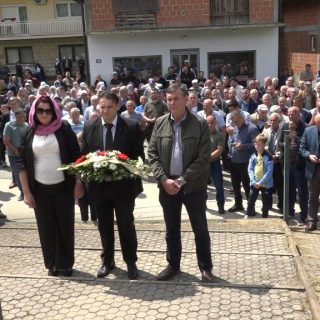There is no culture of memory without confronting the culture of oblivion. According to Prof. Dr. Đokica Jovanović, the culture of memory is only as possible as the ideologized culture of oblivion allows it to be. However, the culture of neglect is neither faced with memory nor oblivion. Its permanent existence does not depend on the presence or erasure of any content that testifies to suffering. Such content simply does not exist because it was never considered as an object of memory.
How else can we explain the lack of accurate data on Roma victims during World War II and the fact that estimates of those killed or who died due to beatings, starvation, or the cold vary by several hundred thousand people? This is not limited to one country but concerns the entire liberated territory of Europe. It is known that the Germans often did not even register detained Roma. Testimonies of survivors reveal that, when “Gypsies” were taken, no lists were made, but Roma were separated into groups of 50 to 200. Moreover, a significant number of Roma, including Travelers and Nomads, were killed where they were found—in camps on meadows and in forests. These individuals were not recorded in population censuses even before the war, nor was there anyone to count them when they were killed.
It is also not entirely known that the German occupying army and collaborationist gendarmerie and police did not cover the trucks used to transport Roma to executions. They believed that taking away “Gypsies” would not significantly disturb the local majority population, which, like all peoples in similar situations, continued their daily lives near the camps.
This is why what happened later, when official fascism no longer existed, should not surprise us. General neglect of all Holocaust victims meant that for Roma, the genocide—known as Samudaripen, a term equivalent to the Jewish term Holocaust—was not discussed until the late 1980s and early 1990s, when the Roma rights movement had matured enough to raise the issue. Like all other “categories” targeted for fascist extermination, Roma had to fight for remembrance on their own. When they did, it was incomplete and with few witnesses.
During proceedings before Yugoslav military courts after the war, the issue of genocide against the Roma was never specifically considered. In the forms of the State Commission for the Investigation of Crimes of Occupiers and Their Collaborators, which was active until 1948, as well as its branches working on detailed invesigations of all crimes, there were no sections for Jews and Roma that would enable determining the number of victims. The experience of separation, discrimination, and subsequent suffering and genocide led to increased social mimicry wherever possible. Learning from their experiences, Roma identified as members of the majority population, even though their places of residence, occupations, and family ties with others labeled as “Gypsies” indicated that they were also Roma. Additionally, historical textbooks omitted the fact that Nazi reprisals—100 hostages killed for one German soldier and 60 for one wounded—primarily meant the killing of Communists, Jews, and Roma. In Serbia, due to a strong uprising and partisan struggles, “racial and political reservoirs” were often insufficient, leading to the execution of members of the majority population as well. Over time, these hostages were categorized as “Serbs,” diminishing the significance of their sacrifices for the national liberation struggle.
Few cases of Roma collaboration with occupiers outside of camps have been documented, usually involving the misuse of Albanian or Bosniak collaborators who offered Roma protection in exchange for joining quisling armies. However, there is little documentation on Roma participation in partisan units, although family histories suggest it was more common.
The culture of neglect, like memory and oblivion, rests on ideological assumptions and is constantly influenced by political changes. Today, we increasingly face the normalization of collaborationism, witnessing the rehabilitation of chetniks, whose atrocities are supported by clear and unequivocal historical evidence. This situation can be described as a continuous anticipation of the next move by the current authorities (from the 1990s to the present), not only in fostering the culture of oblivion but also in its metastasizing and permanent erasure of antifascism. In Belgrade, the destruction of commemorative sites such as cultural monuments and places of detention and suffering has led to collective amnesia about the horrors that occurred there. These sites risk becoming part of the entertainment and consumer industry, such as shopping malls and elite new neighborhoods like Belgrade Waterfront.
In the frantic race of modern politicians to discard any memory of the antifascist struggle and its inseparable connection with socialist Yugoslavia, the atrocities of World War II are increasingly diminished and relativized. This trend supports the denial of suffering, historical testimonies, and the reduction of genocide to collective hallucinations, relativizations, and distortions. While this did not begin with the current government, it is entirely aligned with it.
The voices of Roma are not strong enough to adequately confront the culture of neglect and point out the historical omissions. Roma lack a written history, but perhaps the most striking indicator of the trauma experienced during World War II is the fact that their anthem is a song about the Holocaust. Đelem, đelem is a folk song that was popular among Roma from Moldova to the Balkans long before the war. After the war, this love song transformed into one about separation, killing, and wandering. If an anthem represents the spiritual core of a people scattered across the world, then Roma identity is inseparably tied to the experience of suffering and genocide.
There are fewer survivors of Nazism who were children at the time, leaving fewer opportunities to converse with them and preserve their memories. These children were never truly children, facing the hell of camps and the loss of their loved ones. They grew up quickly without the chance to heal their traumas, striving only to forget. Trauma, as we know, remains in the subconscious, influencing future generations. Our grandparents, and later our parents, transmitted a deep collective and transgenerational trauma, which we, in turn, pass on to our children and future generations. The fact that our ancestors did not speak of the horrors they witnessed and endured during World War II stems from their desire to spare us from their suffering. As Nietzsche suggested, constant and complete memory would be unbearable, making oblivion a blessing.
In this sense, the oblivion of the Roma population is not the same as the neglect of the majority. The Roma people have not forgotten; only younger generations were not burdened with knowledge too horrific to recount. The culture of neglect among the majority population signifies a lack of interest in gaining knowledge or understanding, reflecting a deliberate disinterest in Roma history. The genocide against Roma was not a temporally and spatially isolated event. Their extermination was based on prevailing racial theories, social distancing, and the continuous denial of basic human rights, which was not exclusive to Germany at the time. Consequently, contemporary events cannot and must not be seen in isolation. Instances of brutality against Roma and other groups, such as migrants, form an uninterrupted continuum of slow genocide.
Remembering Roma victims of World War II is not confined to specific commemorations like December 16 (International Day of Remembrance of Roma Victims of World War II), August 2 (International Roma Holocaust Remembrance Day), or April 8 (Roma and Romani Women’s Day). Remembering Roma involves much more. It means introducing another term into the discourse on the culture of memory—acknowledging the culture of neglect—and giving more space to known facts and testimonies while recognizing the ongoing injustice against the Roma people.
Vera Kurtić is a sociologist and activist in feminist, Roma, and LGBTQ movements. She is vegan, considering it a political act recognizing the injustice humanity inflicts on other species. She has authored several articles and a documentary film on folk songs inspired by the suffering of Roma in camps on the territory of present-day Serbia, which serve as indigenous historical testimonies of the Roma people.
Translated by Luna Đorđević




